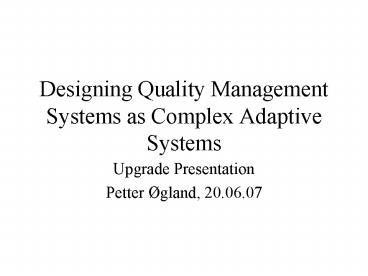Designing Quality Management Systems as Complex Adaptive Systems PowerPoint PPT Presentation
1 / 19
Title: Designing Quality Management Systems as Complex Adaptive Systems
1
Designing Quality Management Systems as Complex
Adaptive Systems
- Upgrade Presentation
- Petter Øgland, 20.06.07
2
Groups of people related to the quality
management system (QMS)
- Customers
- Product/service providers (workers)
- Managers
- TQM agent (Action Researcher)
3
My impression Customers
- Is the service/product okay?
- The inside of the organisation is NOT interesting
(quality policy, quality system, organisation
model, who is head of which department etc)
4
My impression Workers
- When routine work gets boring, try getting
involved in a project for a while (until it
becomes frustrating, then return to routine work
or get involved in another project) - Make sure the boss is sufficiently satisfied
(follow rules and avoid trouble) - Focus on having interesting hobbies and
meaningful life outside of work
5
My impression Management
- Cultivate networks of powerful friends
- Associate with prestigious projects
- Avoid making decisions, in order to avoid making
mistakes (delay until decisions make themselves) - Make others do the work, but
- If things go right, take credit
- If things go wrong, blame others
6
If this model is correct, what would be a good
QMS design?
- It is good for the organisation to be able to
brag about Excellence, TQM, ISO 9000, CMM etc,
but organisational culture works contrary to the
models and standards - Research indicates that mindless installation of
ISO 9000 in such organisations makes them even
worse (Seddon, 2000)
7
What design generates the most adaptable
behaviour? One big brain or many small brains?
8
Individual stupidity and collective smartness
(swarm intelligence)
- Ant colonies, bee hives (Kelly, 1994)
- Ecology, Gaia theory (Lovelock, 1989)
- How the brain works (Pinker, 1997)
- Robot design (Brooks, 1991)
- Sustainable architecture, city design (Brand,
1994) - Global society (Capra, 2002 Urry, 2003)
- Management and organisational theory (Stacey,
1995 Dooley, 1995 Wheatley, 1992)
9
Research problem and methodology
- Research problem How to design quality
management systems in organisations by ignoring
aspects that are out of hand of the designer
(management commitment, corporate culture etc) - Research methodology Design research (Simon,
1996 Hevner, 2004), i.e. iterative design of a
method by focusing on the weaknesses of each
instance of the method, thus contributing to (1)
improvement of the method and (2) filling
theoretical gaps in how to design such methods
10
Initial design Demings process improvement
method (PDCA) seen as a genetic algorithm
(Holland, 1995)
- Act (decide set of cyclic processes for further
improvement, i.e. next generation) - Plan (identify process indicators)
- Do (monitor processes by use of SPC)
- Check (rank processes with respect to errors
Pareto analysis), go to A
11
Visual illustration for the design of the PDCA
improvement method
12
Example Part of case study from the Norwegian
Tax Administration
- Act Set of improvement processes (1) improving
COBOL programming practice, and (2) improving
software documentation practice - Plan Measurements Compliance with standards
(0-100) and other quality/productivity
indicators - Do Monitoring programmers 7 years (SPC),
monitoring documentation process 4 years (SPC). - Check Programming process on ISO 9004 level 1.1,
documentation process on ISO 9004 level 0.9 go
to A (e.g. continue both processes and add a new
process for the improvement pool)
13
Evaluation of initial PDCA design
- Positive The method works. It has been
consistently producing measurable results for all
processes considered - Negative The method is blind to organisational
issues. When the method reveals that people are
not following standards, this may be seen as a
threat to both workers and managers.
Organisational politics works according to the
principles of imperfect information game theory
(e.g. poker), but is now redefined to a perfect
information type of game (e.g. chess).
14
PDCA designs often fails to work in the
bureaucracy. Evaluation is politically challenging
15
Gaining TQM power by establishing external
alliances
- National audit.
- Internal audit.
- Department of Finance.
- Academia Learning from HISP strategies
(Networks of Action, Braa et al, 2004)
16
The action research approach
- How to enrol academia?
- What are the similarities between management and
research? - What are the differences?
- How to make management problems into research
problems?
17
Scientific management from the viewpoint of
quality control (QC)
- Management theory (Fayol, 1916)
- Plan
- Organize, command, coordinate
- Evaluate
- Scientific method as QC (Shewhart, 1938)
- Formulate hypothesis
- Design and perform experiment
- Evaluate
18
Scientific management generates double loop
learning
19
Quality Management Systems as Complex Adaptive
Systems

